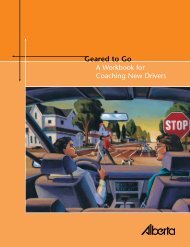Commercial driver's guide to operation, safety and licensing
Commercial driver's guide to operation, safety and licensing
Commercial driver's guide to operation, safety and licensing
Create successful ePaper yourself
Turn your PDF publications into a flip-book with our unique Google optimized e-Paper software.
• ensure the vehicle is inspected,<br />
or make it available for inspection,<br />
as specified in the company’s<br />
preventive maintenance plan<br />
• report any on-road inspections received<br />
from an enforcement officer <strong>and</strong> provide<br />
the documents <strong>to</strong> the carrier<br />
• notify the carrier of any defects found<br />
during an inspection;<br />
• not operate any vehicle with a defect<br />
that would jeopardize the <strong>safety</strong> of the<br />
driver or any other person<br />
For more information, refer <strong>to</strong> the<br />
<strong>Commercial</strong> Vehicle Safety Regulation,<br />
AR 121/2009 which is available through<br />
the Queen’s Printer. (See “Need more<br />
information” at the end of this section.)<br />
Hours of service<br />
Hours of service legislation is <strong>safety</strong><br />
legislation that ensures commercial drivers<br />
have enough opportunities <strong>to</strong> rest so they<br />
do not drive when tired.<br />
There is both federal <strong>and</strong> provincial<br />
legislation that regulates drivers’ hours of<br />
work. Alberta legislation applies <strong>to</strong> carriers<br />
<strong>and</strong> their drivers who operate vehicles<br />
solely within Alberta. The federal legislation<br />
applies <strong>to</strong> carriers <strong>and</strong> their drivers who<br />
operate one or more vehicles outside of<br />
Alberta. Once it has been determined<br />
that a carrier falls within the federal<br />
legislation, all the drivers of the carrier’s<br />
regulated vehicles must comply <strong>to</strong> federal<br />
requirements, even those that never leave<br />
Alberta. The main regula<strong>to</strong>ry requirements<br />
are summarized below. To fully underst<strong>and</strong><br />
all requirements, one must read the<br />
applicable regulations.<br />
Provincial (Alberta)<br />
legislation<br />
The on-duty hours (consisting of “driving”<br />
<strong>and</strong> “on-duty not driving” time) allowed<br />
for a driver are regulated in work shifts<br />
that generally start after having a period<br />
of eight consecutive hours off-duty <strong>and</strong><br />
end when the driver has another period of<br />
eight consecutive hours off-duty. Some<br />
situations are considered equivalent <strong>to</strong> this<br />
eight hour off-duty requirement.<br />
During a work shift, a driver cannot drive:<br />
• after having driven 13 hours; or<br />
• after being on-duty for 15 hours<br />
A driver must account for every day by<br />
completing a daily log for each calendar<br />
day, or indicating in the remarks section of<br />
the daily log that the driver was off-duty on<br />
the indicated dates.<br />
When required <strong>to</strong> complete a daily log, a<br />
driver must do the following:<br />
• enter all the required information<br />
• maintain the daily log current <strong>to</strong> the last<br />
change of duty status, such as off-duty<br />
time <strong>and</strong> driving time<br />
• maintain the daily log accurately<br />
• keep copies of documents received<br />
during the trip, such as hotel receipts<br />
<strong>and</strong> fuel receipts<br />
• deliver the daily log, <strong>and</strong> all supporting<br />
documents, <strong>to</strong> the employer within<br />
20 days<br />
• keep a copy of each daily log <strong>and</strong><br />
supporting documents for at least<br />
six months<br />
If ALL of the following four conditions<br />
are met, a daily log is not required <strong>to</strong> be<br />
completed. (however, all other regulated<br />
requirements must still be met):<br />
20 A <strong>Commercial</strong> Driver’s Guide <strong>to</strong> Operation, Safety <strong>and</strong> Licensing




